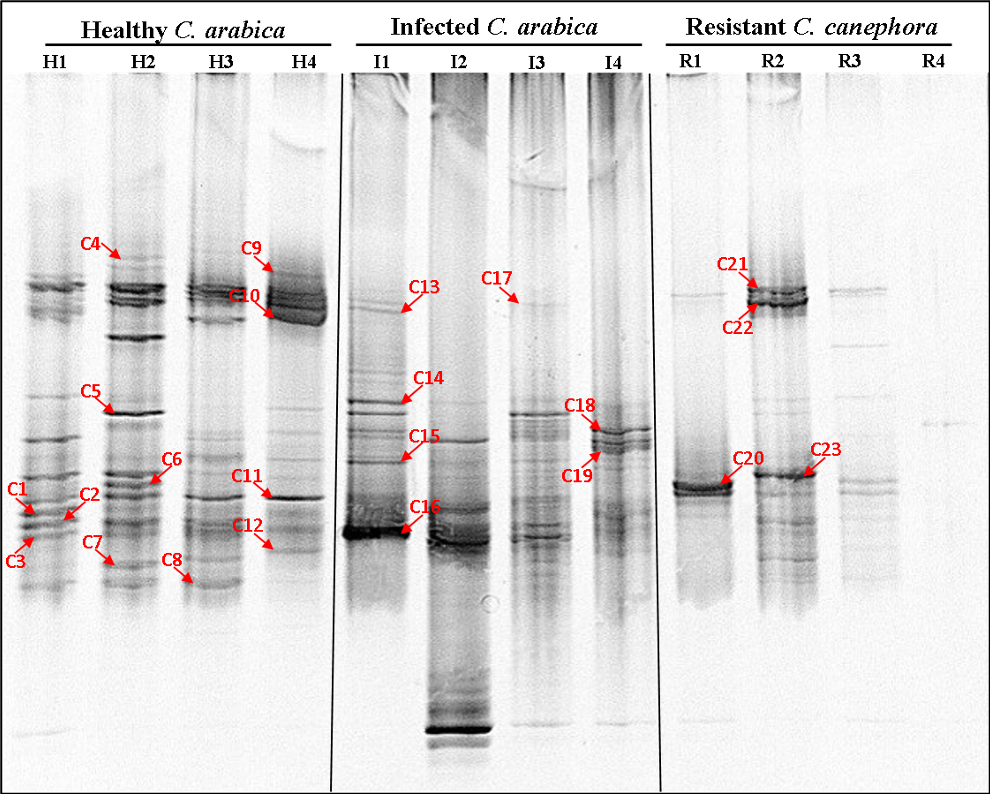VOLUME 13 (Supplement)

Philipp. Sci. Lett. 2020 13 (Supplement) 024-041
available online: July 29, 2020
*Corresponding author
Email Address: agestopace@up.edu.ph
Date received: January 15, 2020
Date revised: April 13, 2020
Date accepted: April 13, 2020
ARTICLE
Endophytic bacteria associated with healthy and rust-infected Coffea arabica L. leaves
University of the Philippines Diliman, Quezon City
1101, Philippines
Coffea arabica L., the most commercialized species of coffee, has been continuously devastated by the Coffee Leaf Rust (CLR) disease worldwide. A recent outbreak of the disease in Central America caused the loss of more than 616 millon USD in coffee production. However, the control and prevention of CLR remains to be challenging especially now that climate change is significantly affecting environments globally and there is limited information known about the biotic interactions that surrounds this infection. Hence, in this study, the endophytic bacteria associated with healthy and CLR infected C. arabica var. yellow bourbon (a susceptible variety) leaves as well as leaves from C. canephora var. robusta (a resistant variety) were examined individually via culture-independent and culture independent methods to determine whether there are differences in the biotic composition of each. Achromobacter, Alcaligenes, Citrobacter, Delftia, Erwinia, Exiguobacterium, Hafnia, Hydrogenophaga, Janthinobacterium, Luteibacter, Novosphingobium, Staphylococcus, Thiobacillus, and Wolbachia were identified as new records of bacterial endophytes in coffee leaves. CLR infected leaf samples had the most diverse endophytic bacterial community with a total of 13 genera while healthy Yellow Bourbon and resistant Robusta leaves had 8 and 9 genera, respectively. This study is the first to report the difference in the microbiome of healthy and CLR infected coffee leaves. Unique species per leaf sample were also identified. Using culture-dependent isolation, Bacillus, Curtobacterium, Enterobacter, Erwinia, Hafnia, Novosphingobium, and Stenotrophomonas were found only in the CLR infected Yellow Bourbon leaves. On the other hand, Staphylococcus was only isolated from healthy Yellow Bourbon leaves, while Achromobacter, Alcaligenes, Citrobacter, and Luteibacter were only isolated from the resistant Robusta leaves. In the case of the culture-independent method, additional genera like Hydrogenophaga and Wolbachia were identified as unique in healthy leaves, while Achromobacter, Alcaligenes, and Citrobacter were found to be unique in resistant leaves. Hydrogenophaga and Achromobacter are known plant-growth promoting bacteria, which can be studied further for their possible biocontrol properties against H. vastatrix while unique phytopathogens in infected leaves, such as, Erwinia can be studied for their association in CLR development.
© 2025 SciEnggJ
Philippine-American Academy of Science and Engineering